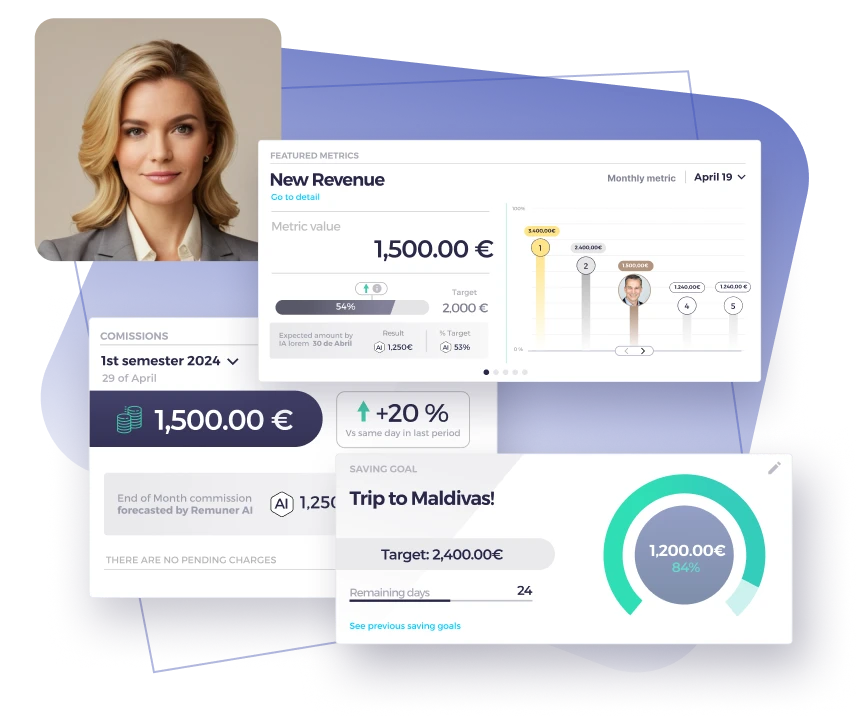Table of contents
What Is Sales Efficiency?
Sales efficiency measures how effectively a company turns sales and marketing spend into revenue. It shows if your sales team generates maximum value from every dollar spent on sales. High sales efficiency reflects a streamlined sales process, strong win rates, and effective sales training.
Imagine a company that invests significantly in training and optimizing its sales process; they typically experience a noticeable improvement in their sales efficiency ratio, indicating more effective resource usage.It answers the critical question: “For every dollar we invest in sales, how much revenue do we generate?”
How to calculate sales efficiency
The standard formula for calculating sales efficiency (often referred to as the “magic number”) is:
Sales Efficiency = Revenue Generated / Sales and Marketing Spend
For example, if your sales and marketing spend in Q1 was $50,000, and you generated $150,000 in revenue, your sales efficiency would be:
$150,000 ÷ $50,000 = 3.0
This means that for every dollar spent on sales, your company earns three dollars back. Companies should track both gross sales efficiency (new customer revenue only) and net sales efficiency (new revenue plus expansion revenue minus churn).
Gross Sales Efficiency vs. Net Sales Efficiency: Learn the difference
- Gross Sales Efficiency: Measures new ARR generated from brand new customers only. It’s essential for assessing how effective your sales team is at acquiring new business.
- Net Sales Efficiency: Includes revenue from new customers plus expansions, minus any churned revenue. I also offers a comprehensive perspective, indicating overall company growth and customer retention.
Remuner provides an automated tool to accurately track and analyze these metrics, ensuring you always have real-time insights into your sales efficiency.
Why sales efficiency is important
Sales efficiency impacts a company’s profitability and long-term growth. Here’s why it matters:
1. Lowers Customer Acquisition Cost (CAC)
Inefficient sales processes inflate CAC. For example:
- Company A: Spends 50K to acquire 10 customers→ 50K to acquire 10 customers→5K CAC
- Company B: Spends 50K to acquire 25 customers→ 50K to acquire 25customers→2K CAC
Company B’s higher efficiency means faster growth at lower costs.
2. Improves Cash Flow & Profitability
Efficient teams generate more revenue without proportionally increasing spend. This is crucial for startups needing to extend runway and enterprises aiming to improve margins.
3. Reveals Process Bottlenecks
Tracking efficiency helps pinpoint issues like:
- Poor lead qualification (high spend, low conversions)
- Lengthy sales cycles (delayed revenue)
- Misaligned compensation (reps focusing on low-value deals)
4. Supports Data-Driven Decisions
Instead of guessing, you can:
- Allocate budget to high-performing channels
- Adjust quotas based on realistic conversion rates
- Invest in tools that directly impact revenue
What is a good sales efficiency ratio
A good ratio usually falls between 1.0 and 3.0:
- Below 1.0: Indicates inefficiency; your company might be overspending relative to revenue generated.
- 1.0 to 3.0: Considered healthy, balancing spending and growth effectively.
- Above 3.0: Suggests potential underinvestment in growth opportunities, indicating your company might grow faster by spending more strategically.
Factors that influence your ratio
- Business Model: SaaS companies often have higher ratios due to recurring revenue.
- Sales Cycle Length: Longer cycles may temporarily lower efficiency.
- Market Conditions: Competitive industries may require higher spend.
Sales Efficiency vs. Sales Effectiveness
While often confused, sales efficiency and sales effectiveness measure different aspects of your sales performance:
- Sales Efficiency focuses on cost-effectiveness—how much revenue you generate per dollar spent.
- Sales Efficiency Metrics: Includes revenue per sales rep, cost per lead, gross/net efficiency ratios, and customer acquisition cost (CAC).
- Sales Effectiveness emphasizes the quality of sales activities—like win rate and conversion rate.
- Sales Effectiveness Metrics: Focuses on conversion rate, win rate, average deal size, and sales cycle length.
10 strategies to improve sales efficiency
Improving sales efficiency ensures you get the most revenue from each dollar spent on sales and marketing. To achieve this, businesses must implement actionable strategies. Here are 10 proven strategies to boost your sales efficiency:
1. Invest in sales training
Regular sales training equips your sales reps with the necessary skills to succeed in a highly competitive environment. Effective training programs teach advanced selling techniques, objection handling, negotiation tactics, and the ability to recognize customer needs quickly.
Ongoing training ensures reps stay updated on industry trends, products, and market dynamics. Companies committed to consistent training report significantly higher productivity and greater revenue per sales rep compared to those neglecting training. According to CSO Insights, companies with structured sales training programs achieve quota attainment rates approximately 30% higher than those without dedicated programs.
2. Automate sales processes
Automating repetitive tasks such as data entry, scheduling follow-ups, lead assignment, and sending emails frees up valuable time for sales reps to focus on closing deals. Automation tools streamline workflows and significantly enhance productivity, reducing human error and increasing responsiveness.
Companies adopting sales automation solutions often experience productivity improvements of up to 30%. By integrating sales automation into your processes, your sales reps dedicate more time to high-value activities such as personalized customer interactions, relationship building, and strategic selling, leading directly to higher sales efficiency.
3. Track sales efficiency metrics regularly
Regular tracking metrics helps you quickly identify and address performance issues. Key metrics you should regularly measure include:
- Win rate
- Conversion rate
- Cost per acquisition
- Net sales efficiency
- Average deal size
Organizations that track sales metrics weekly or monthly achieve approximately 25% higher conversion rates compared to those tracking less frequently.
4. Enhance lead qualification
Improving lead qualification helps your sales team focus on high-potential leads, boosting efficiency. To effectively qualify leads, consider using frameworks like BANT (Budget, Authority, Need, Timing). Benefits of enhancing lead qualification include:
- Increased conversion rates
- Reduced sales cycle length
- Less time spent on low-quality leads
Gartner indicates effective lead qualification can boost sales productivity by around 20%.
5. Clarify quotas and compensation
Clearly defined and attainable quotas coupled with competitive compensation structures significantly improve sales incentives and motivation. Sales reps are more driven when they understand their targets and see clear alignment between their efforts and rewards. Companies that align their compensation clearly with sales quotas report around 15% higher quota attainment rates.
6. Improve sales-marketing alignment
Misalignment between sales and marketing teams often leads to lost opportunities and decreased efficiency. Strengthening alignment ensures smoother lead transitions, consistent messaging, and better customer experiences. Improve alignment by holding regular joint meetings, establishing shared goals and KPIs, creating unified messaging strategies and clarifying lead-handoff processes.
7. Optimize sales funnel stages
Streamlining your sales funnel reduces bottlenecks, improves customer experiences, and accelerates deal closures. Evaluate your sales funnel regularly by:
- Identifying slow stages in the process
- Simplifying proposal and negotiation stages
- Automating follow-ups and check-ins
- Eliminating unnecessary steps
Businesses optimizing their funnel stages can shorten sales cycles by approximately 28%.
8. Use data-driven insights
Making decisions based on reliable data rather than intuition significantly improves it. Data-driven insights can:
- Identify the most effective sales channels
- Pinpoint the highest-performing reps
- Highlight winning sales tactics
- Forecast customer buying behaviors
McKinsey & Company found that data-driven sales organizations increase revenue by up to 20%.
9. Implement sales enablement tools
Sales enablement tools empower reps to sell more efficiently by giving them quick access to essential information, insights, and resources. These tools include:
- CRM systems for customer tracking
- Content management platforms for easy asset access
- Sales intelligence software for deeper market insights
- Communication platforms for team collaboration
CSO Insights states organizations using mature sales enablement practices achieve approximately 32% higher quota attainment.
10. Continuously refine strategies
It requires regular adjustments and improvements based on market changes, customer feedback, and internal data. To continuously refine your strategies:
- Conduct regular performance audits
- Hold frequent strategy reviews
- Collect and act on sales rep feedback
- Adapt quickly to new industry trends
FAQs about Sales Efficiency
What does sales efficiency measure?
Sales efficiency measures how effectively your sales and marketing spending translates into revenue.
How do you improve sales efficiency?
You improve it by setting clear quotas, automating processes, aligning sales and marketing, optimizing compensation structures, and continuously tracking performance metrics.
What’s the difference between gross and net sales efficiency?
Gross sales efficiency considers total new revenue. Net sales efficiency subtracts lost revenue (churn and downgrades) from new revenue to give a clearer picture of true growth.
How often should you calculate sales efficiency?
Quarterly is standard, but high-growth teams may track monthly.
![Sales Efficiency: How to Calculate & Improve It [Full Guide]](https://www.remuner.com/wp-content/uploads/2025/03/sales-efficiency.webp)




